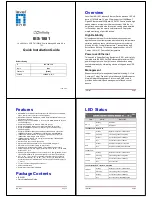
1-5
Cisco MGX 8800/8900 Series Hardware Installation Guide
Releases 2 - 5.2, Part Number OL-4545-01, Rev. H0, May 2006
Chapter 1
Product Overviews
How this Chapter Is Organized
Note
The information in this guide does not apply to the Cisco MGX 8850 (PXM1), which uses the PXM1
controller card and Release 1.X software.
For documentation on Cisco MGX Release 1.x software and hardware, refer to
http://www.cisco.com/univercd/cc/td/doc/product/wanbu/mgx8850/index.htm
.
Multiple Terms
Inside and outside of Cisco, several terms are often used for the same thing. Here are some examples:
•
MGX switches contain printed circuit cards called
front cards
and
back cards.
Cards are also called
blades
,
modules,
or
boards
. A controller card is sometimes simply called a
controller
. In this guide,
the terms
module
is used for a front card and
card
is used for every other type of card.
•
An interconnect device that enables redundant operation between cards is called a
midplane
, an
automatic protection switching (
APS) backplane connector
, or an APS connector. An additional type
of connector that enables redundancy is a
redundancy connector
(RCON).
•
Single-height slots can be converted to double-height slots by removing the
center guide modules
.
Center guide modules are also called
center guides
,
midrail dividers, or service module slot divider
assemblies.
In this guide, the term
center guide module
is used.
•
In the back of the switch, back cards go into bays. The
upper bay
is also called
Bay 1
, and the
lower
bay
is also called
Bay 2
.
Figure 1-3
shows the bay and line numbers for an MGX 8850 switch.
•
The MP port on the back of the PXM-UI-S3 user interface back card stands for
maintenance port
or
modem port
. The CP port on the back of the PXM-UI-S3 user interface back card stands for
control
port
or
console port.
















































